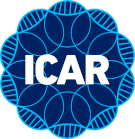Section 08 – Certificate of Quality: Difference between revisions
| Line 101: | Line 101: | ||
= Certification requests = | = Certification requests = | ||
<div class="mw-collapsible mw-collapsed"> | |||
<div> | |||
Any ICAR member can request certification by application to the ICAR Secretariat. The member decides which fields of activity they want to certify and states those fields of activity in the application, keeping in mind that activities performed outside the member organisation, or not practiced at the time of certification cannot be certified. The application forms are found in the appendix to this Guideline. | |||
</div> | |||
</div> | |||
= Audit procedure = | = Audit procedure = | ||
Revision as of 07:14, 16 July 2024
Introduction
Preamble
The ICAR Certificate of Quality programme was established by the 2006 ICAR General Assembly. It replaced the earlier use of the permanent ICAR Special Stamp, which became invalid by 2009.
Purpose
The purpose of the ICAR certificate of quality is to support ICAR member organisations in maintaining a high quality of service in those fields of activity that ICAR has guidelines for or are otherwise within the scope of the work of ICAR, and to ensure continuous improvement in service quality.
Benefits
The benefits of the ICAR Certificate of Quality to member organisations include:
- A unique mark that identifies product and service quality for customers which meets or exceeds the published ICAR guidelines
- A marketing tool for organisations which will identify their conformance with internationally recognised standards
- A time-sensitive approval period which will ensure to customers that the service provider has routinely met the ICAR criteria thereby providing enhanced confidence in the quality of service or product received.
- A mark of the demonstrated leadership of ICAR in the international marketplace through the provision of value-added services for its members.
- An advisory review carried out by independent experts.
Scope
The expert advisory group
The ICAR Chief executive (CE) appoints a chairperson and members to the Expert advisory group on the ICAR Certificate of quality. The objectives of the CoQ EAG are to provide advice and recommendations to the ICAR Chief executive on:
The content of the CoQ programme
- Fields of Activity (FoA) to be audited
- Content and relevance of the Questionnaires
- Questions and criteria in the Questionnaires
- Key performance indicators (KPI) for each FoA
- Methods of evaluation for each FoA
- Rules for the CoQ programme
The Management of the CoQ programme
- Quality Management of the CoQ programme
- Auditor recruitment, evaluation, and training
- Assigning of auditors to events
- Post-Audit/Review surveys and other relevant surveys
- Ownership of the relevant SOP’s and Section 8 of the Guidelines
- Provide critical input into other sections of the Guidelines and the Guidelines in general
- Liaise with Chairpersons of WG’s and SC’s as necessary
- Liaise with the ICAR Secretariat as necessary and ensure forms on website are updated.
The expert advisory group communicates with the ICAR Board:
- Annual report of the CoQ EAG Chairperson to the Chief Executive who will report to the ICAR Board.
- CoQ EAG Chairperson to participate in meetings of Group Chairs with ICAR Board.
- The ICAR Staff support person as identified from time to time by the ICAR Chief Executive. All communications with the EAG are to be copied to this person.
- Participation by the Chairperson in meetings with the Chief Executive, at least once per year.
Questionnaires and evaluation grounds
Audit and consultative review questionnaires are designed and updated by the Certificate of Quality Expert Advisory Group. The group is also responsible for creating key performance indicators for each field of activity, and for keeping the evaluation grounds unified.The fields of activity available for certification
The fields of activity available for certification are determined by the EAG and updated in this Guideline whenever there are changes.
Certification is possible in at least the following fields of activity:
- Animal identification (cattle)
- Animal identification (other species)
- Milk recording (cattle)
- Beef recording (cattle)
- Milk recording (other species)
- Meat recording (other species)
- Production recording (other traits)
- Herdbook recording
- Conformation recording
- Data processing
- Laboratory analysis (milk)
- Reference laboratory (milk)
- Laboratory analysis (DNA)
- Genetic evaluation (dairy cattle)
- Genetic evaluation (beef cattle)
- Genetic evaluation (other species)
These fields of activity are applicable to cattle and other relevant farm animals such as buffaloes, goats, sheep and camelids.
Certification requests
Any ICAR member can request certification by application to the ICAR Secretariat. The member decides which fields of activity they want to certify and states those fields of activity in the application, keeping in mind that activities performed outside the member organisation, or not practiced at the time of certification cannot be certified. The application forms are found in the appendix to this Guideline.

